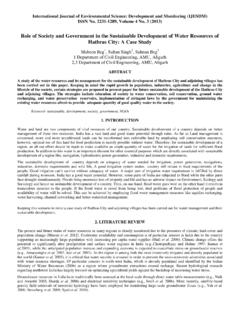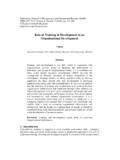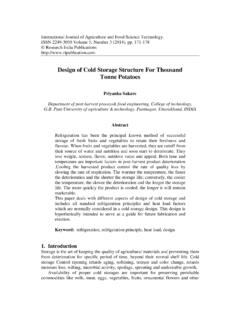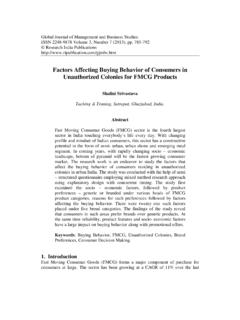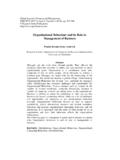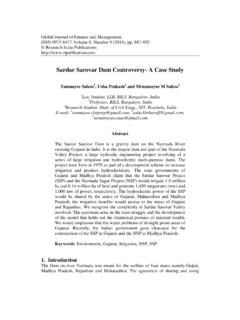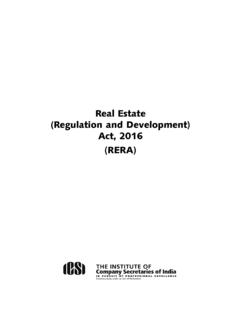Transcription of Environmental Degradation in India: Causes and …
1 International Journal of Applied Environmental Sciences ISSN 0973-6077 Volume 11, Number 6 (2016), pp. 1593-1601. Research india Publications Environmental Degradation in india : Causes and Consequences Rajiv Chopra OSD- Principal, Department of Commerce, Delhi College of Arts and Commerce, Netaji Nagar, University of Delhi, Delhi-110023, india . Abstract Environmental Degradation is the disintegration of the earth or deterioration of the environment through consumption of assets, like, air, water and soil. The destruction of environments and the eradication of wildlife. Air pollution, water pollution, garbage, and pollution of the natural environment are all challenges for india . According to World Bank experts, between 1995.
2 Through 2010, india has made one of the fastest progresses in the world, in addressing its Environmental issues and improving its Environmental quality. Still, india has a long way to go to reach Environmental quality similar to those enjoyed in developed economies. Pollution remains a major challenge and opportunity for india . Environmental Degradation is one of the primary Causes of diseases, health issues and long term livelihood impact for india . Environment can be defined as the physical surrounding of man/woman of which he/she is a part and on which he/she is dependent for his/her activities like physiological functioning, production and consumption. His physical environment stretches from air, water and land to natural resources like energy carriers, soil and plants, animals and ecosystems.
3 The relationship between physical environment and the well-being of individuals and societies is multi-fold and multi-faceted with a qualitative as well as a quantitative aspect to it. The availability and use of natural resources have a bearing on the outcome and the pace of development process. For an urbanized society, a large part of environment is man-made. But, even then the artificial environments (building, roads) and implements (clothes, automobiles) are based on an input of both labour and natural resources. The term Environment' is commonly restricted to ambient environment. In that view, the indoor environment 1594 Rajiv Chopra (home, work place) is regarded as isolated piece of environment to be treated on its own terms.
4 The indoor environment usually is under the jurisdiction of the Public Health authorities. Health risks are mainly linked to space heating, cooking and lighting: low grade fuels, insufficient ventilation are often the main problems. Additionally, there may be problems connected with moisture, light, incidence, hazardous substances from building materials, lacquers and paints. Problems with drinking water, sewage and waste are not linked to the dwelling as such but rather to lack of appropriate infrastructure. Statistics on indoor environment may be regarded as a subset of statistics on human settlements and the urban environment (COES, 2013). The sustainable administration of the earth and natural resources is essential for financial development and human prosperity.
5 At the point when overseen well, inexhaustible characteristic assets, watersheds, profitable scenes and seascapes can give the establishment to supported comprehensive development, sustenance security and poverty reduction. natural resources give vocations to a huge number of individuals and create sizeable assessment income. The world's biological communities manage the air, water and soil on which we as a whole depend. They frame a special and practical cradle against extraordinary climate occasions and atmosphere change. Healthy biological systems are basic for the long haul development of financial areas, for example, agribusiness, ranger service, fisheries and tourism. They as of now give countless occupations.
6 In developing nations, woods, lakes, streams and seas give a noteworthy offer of families' eating regimens, fuel and livelihoods and speak to a valuable security net in the midst of emergency especially for 78 for each penny of the world's outrageous poor who live in rustic territories. The integrity and functionality of these vital natural assets, however, are increasingly compromised. 60 to 70 per cent of the world's ecosystems are degrading faster than they can recover. There are many Environmental issues in india . Air pollution, water pollution, garbage, and pollution of the natural environment are all challenges for india . The situation was worse between 1947 through 1995. As per information accumulation and condition evaluation investigations of World Bank specialists, between 1995 through 2010, india has gained one of the speediest ground on the planet in tending to its natural issues and enhancing its ecological quality.
7 Still, india has a long way to go to reach Environmental quality similar to those enjoyed in developed economies. Pollution remains a major challenge and opportunity for india . Environmental issues are one of the primary Causes of disease, health issues and long term livelihood impact for india . Causes OF Environmental Degradation . The major Causes of the Environmental Degradation are modern urbanization, industrialization, over-population growth, deforestation etc. Environmental pollution refers to the Degradation of quality and quantity of natural resources. Various types of environmentaldegradation in india : Causes and Consequences 1595. the human exercises are the fundamental reasons of Environmental Degradation .
8 These have prompted condition changes that have turned out to be hurtful to every single living being. The smoke radiated by the vehicles and processing plants expands the measure of toxic gases noticeable all around. The waste items, smoke radiated by vehicles and ventures are the fundamental driver of contamination. Spontaneous urbanization and industrialization have caused water, air and sound contamination. Urbanization and industrialization help to expand contamination of the wellsprings of water. So also, the smoke discharged by vehicles and ventures like Chlorofluorocarbon, nitrogen oxide, carbon monoxide and other clean particles dirty air. Neediness still remains an issue at the base of a few ecological issues.
9 SOCIAL FACTORS. Population The rapid population growth and economic development in country are degrading the environment through the uncontrolled growth of urbanization and industrialization, expansion and intensification of agriculture and the destruction of natural habitats. One of the significant reasons for Environmental Degradation in india could be ascribed to quick development of population which is antagonistically influencing the natural resources and condition. The developing population and the ecological weakening face the test of maintained improvement without natural harm. The presence or the nonattendance of ideal characteristic assets can encourage or hinder the procedure of economical development. Population is an important source of development, yet it is a major source of Environmental Degradation when it exceeds the thresh hold limits of the support systems.
10 Unless the connection between the multiplying population and the existence emotionally supportive network can be settled, improvement programs, howsoever, imaginative are not prone to yield wanted outcomes. Population impacts on the environment primarily through the use of natural resources and production of wastes and is associated with Environmental stresses like loss of biodiversity, air and water pollution and increased pressure on arable land. The increase in population has been due to the improvement in health conditions and control of diseases. The density of population has gone up from 117 in 1951 to 312 in 2001 and further to 382 persons in 2011 per square kilometer. A few push and draw factors are ventured to be agent towards trouble out relocation from rural to urban regions.
